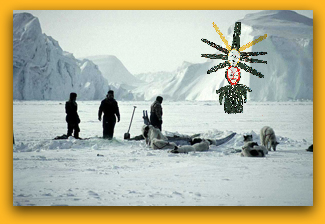
 |
 |
Inuit
Culture and |
|
Alcoholism is still a large issue in the Innu society, and in the 1980's they began intensive alcohol treatment programs so that they could heal the wounds inflicted upon them as a result of government policies and alcohol abuse. In the community of Pakua Shipi, they can depend on a free clinic offering general health services. In 1989, the Inuit established a program called "Cariboo" (PNLAADA), Prevention of Alcoholism and Toxicomania and the national program fighting against drug and alcohol abuse (Denise Charron, 1994). This is just the beginning, as far as the Innu are concerned. They are assuming increasing levels of control over their lives by taking over many elements of public administration, local government and municipal service (Denise Charron, 1994). As I was speaking to the present family of Peter Leon, they mentioned that the community of St. Augustin had lived in a different economic situation for many years, because it was left alone by the Canadian and Quebecois governments, isolated from large decision-making centres; and the only way to reach either St. Augustin or Pakua Shipi is by air or ferry. Despite all this, it demonstrates a great deal of dynamism in all its projects and looks to the future with optimism. To this present day, the community of Pakua Shipi is preoccupied equally with its political future. It participates with eight years of community members in the Council of Atkamekw and the Montagnais (Innu) in the process of negotiations for reservation lands according to ancestral rights. This process began in 1976, and the negotiations are still active. The Innu community of Pakua Shipi counts on playing a primary role in the development of its region (Denise Charron, 1994). Certain facts have been revealed and ideas changed as I investigated the family and ethnic background of Peter Leon. He, in fact, was not Inuit, as it had been believed, but his wife was. He originally came from the Channel Islands called Jersey. The actual date of his arrival to Canada is not known, but the history of the arrival of Jersey men gives an approximate date. All of this research I have done concerning one family's ethnic background has enlightened me about the historical background of the Innu-Inuit relationship with white society. I have found that the treatment the natives received from the white culture is universal; they were controlled and assimilated into the mainstream of white society in order for Europeans to profit in the socio-economic, political game plan. This obviously increased racial discrimination and prejudices and decreased the native's cultural values. In other words, it created a defined dichotomy (between
the natives and the white people) as a controlled socio-economic structure
of imprisonment, where the natives had no place to go for a better livelihood,
similar to the dilemma of Peter's wife. Through this process of institutionalization,
it created growth for trade and growth in industry through socio-economic
interactions with the natives, which in turn changed and governed Inuit-Innu
behaviour and places of residence.
BIBLIOGRAPHY Charron, Denise (1994). Pakua Shipi: Institut culture /et educatif
Cox, Bruce, Alden (1987). Native People, Native Lands: Canadians,
Dickason, Olive, Patricia (1997). Canada's First Nations: A History
of Harper, Francis (1964). The Friendly Montagnais And Their
Neighbours In Hazen-Hammond, Susan (1999). Spider Woman's Web. Traditional Native Kleivan, Helge (1966). The Eskimos of Northeast Labrador: A History
of Knight, Kevin (1999). The Catholic Encyclopedia. Kulchyski, Peter, Don McCaskill, and David Newhouse (1999). In The
Labrador Inuit Association (1977). Our Footprints Are Everywhere:
Inuit Leacock, Eleanor, Burke (1954). The Montagnais "Hunting Territory"
And Morrison, Kenneth M. (1986). Montagnais Missionization In Early New
Muller-Wille, Ludger (1983). Inuit Place Name Inventory of Noel, Michel (1997). The Native Peoples of Quebec. Les editions
Sylvain Speck, Frank, Gouldsmith (1977). Naskapi: The Savage Hunters of the
Steckley, John (1999). Beyond Their Years. Five Native Women's Stories.
Storm, Hyemeyohsts (1973). Seven Arrows. Random House Inc., New
Taylor, Garth, J. (1974). Labrador Eskimo Settlements of the Early
Turner, Lucien, M. (1979) Indians and Eskimo in the Quebec-Labrador
|
|